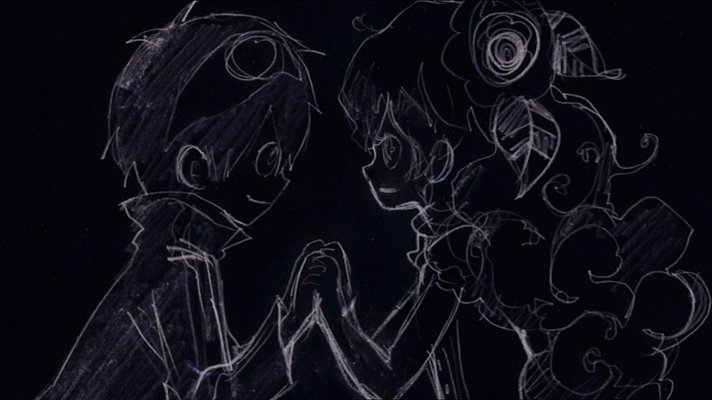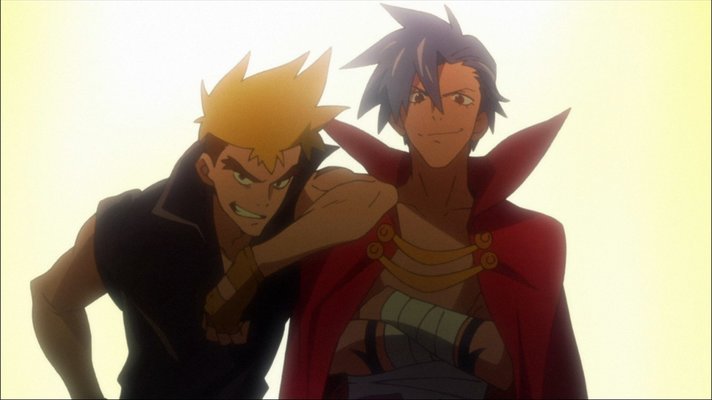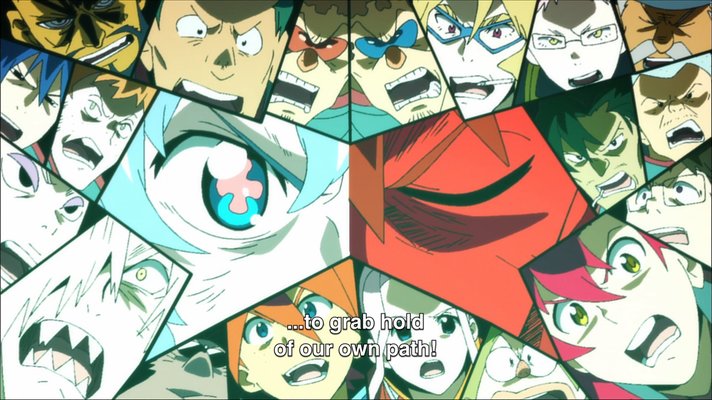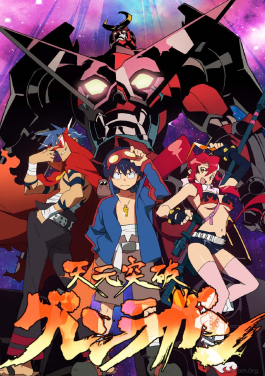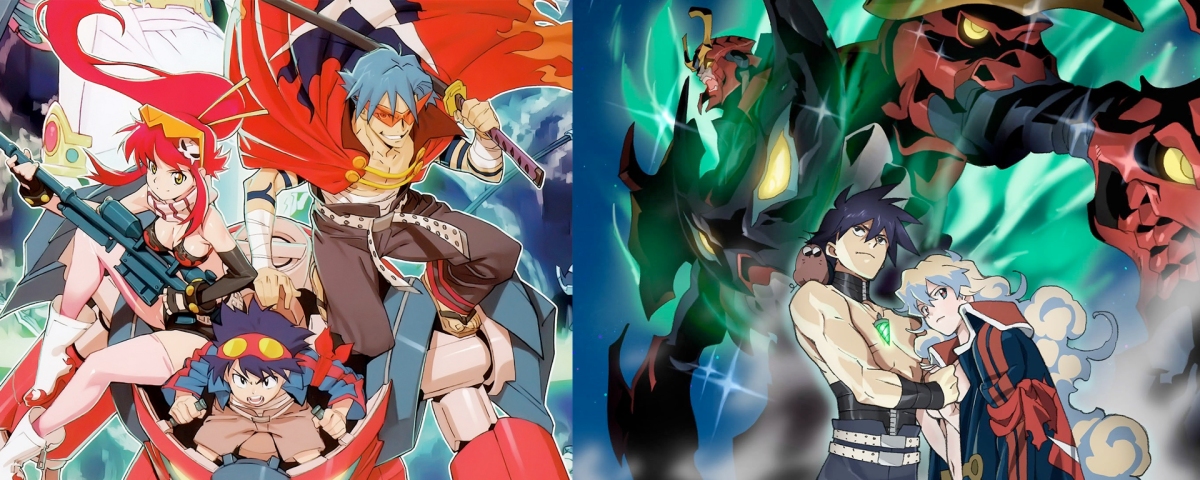Movie #2: The Lights in the Sky Are Stars
"My dream is to cover the whole surface of the world with flowers. ... I'll irrigate the parched earth, plant seeds and make flowers grow. I'll plant trees and turn the brown soil green. And then insects, animals, humans and all sorts of other creatures will live there. I want to make the surface a world that's bursting with flowers and plants and living things."
And this is the touching sentiment that gives old Simon the reason for living his life as a drifter. It's an inspired addition to the story, and that's very typical of movie #2. With a second pass at the material, Gainax have absolutely excelled, creating something that, for my money, is thematically even stronger and a
very pure viewing experience.
Let's get into some detail.
The first thing I'd like to focus on is the newly named Cathedral Lazengann and its excellent transforming sequence. We've already covered
@João Gomes's "It's gonna punch the Earth" moment, so 'nuff said there. Another part of this new concept is the clever idea to have the robot later "devolve" into the form of a battleship so that the rest of the original sinking sequence from the series can be used as-is. Writer Kazuki Nakashima is, put quite simply, a master of context. He can take a fixed point in the plot and come up with a completely plausible reason for its presence. I mean, if he can come up with an indisputably logical reason for combat uniforms being so skimpy in
Kill la Kill, then there's surely nothing he can't sell his audience on!
Next, there seems to be a heavy recontextualising of the Lordgenome back story footage from
Parallel Works at work here. In the original animation, it's Lordgenome himself who defeats the Spiral forces, singlehandedly, having turned against them after learning of the danger of Spiral Nemesis from the Anti-Spiral. In movie #2, though, the accompanying narration from Rossiu talks of how the Anti-Spiral, once a Spiral race themselves, "revolted against the other Spiral races", resulting in the Spiral forces led by Lordgenome being "crushed" and Earth falling under Anti-Spiral control. It also relates how Lordgenome "surrendered". This part is careful enough to use footage that shows a bunch of mecha being attacked by an unseen enemy with drill tentacles; in the original short, the tentacles belonged to Lordgenome's Lazengann. Movie #1, however,
did already use footage from that same scene, showing Lazengann apparently attacking the Spiral forces as part of its opening scene setter, which was narrated by both Lordgenome and the Anti-Spiral.
There's another later sequence in movie #2 using more of the
Parallel Works footage where the Lordgenome head explains that the reason he and his forces could not previously defeat the Anti-Spiral was that they were unable to locate their enemies' homeworld. He also states that the Cathedral Lazengann was "stolen" by the Anti-Spiral and disguised as the moon, being incorporated into their Humanity Annihilation System.
I'm not quite sure what to make of it all. Is the movie #1 opening Lordgenome giving the viewer the "true" story in abstract form, and the later explanations given by the Lordgenome head are partly fabrication? Our heroes only have a biocomputer's version of events to go by, after all, so who can say for sure? There appear to be some contradictions in any case, even disregarding the original
Parallel Works short.
Much easier to understand is the really neat 3D wireframe Lordgenome hacking sequence. It allows another shortcut in the story and injects a great bit of humour at the same time. Gainax even got to reuse the bit of animation where Lordgenome's head crashes against the side of his glass dome in another new context!
Then we've got the reworking of the origin of the Space Gunmen. "They were lying around in this behemoth's hangar. Looks like your Gunmen were these things' mobile cockpits," explains genius engineer Layte of their sudden appearance inside the Cathedral Lazengann. It's done due the much shorter timespan that the film storyline takes place over, and gives our gang ready-made kit to reuse in humanity's latest battle against the Anti-Spiral.
This could have potentially created a plot hole, seeing as how the Grapearl Squadron mecha were only designed and built during the seven-year time skip between the two story arcs, but the writing has that covered, too. Back to Layte:
"There weren't any jumbo Grapearls, but I did find some mass-production models they could use: Space Gunmarls."
Giant mass-production Lazenganns. Genius.

And from there, Simon and the gang immediately set off to fight the Anti-Spiral. In the series, the newly acquired Cathedral Terra returned to Earth to allow everyone to regroup and recover, but the film has no such time to waste. The passengers are instead returned to Earth inside escape pods carried by Grapearls in a clever little new cut. (There was a further new cut that featured
fire and rescue Grapearls during the earlier scene where part of Kamina City was accidentally destroyed in the first fight against the Muganns. The earliest seeds of
Promare, perhaps?) And then we're blasting off! There's no proof that Simon even stops for a p*ss or anything to eat!

Did anyone else notice that when Super Galaxy Gurren Lagann warps, flash forms shape of Simon's sunglasses' star-shaped final form?
We've heard already about the epicness that is the deciding battle against the Anti-Spiral, but... I just love the way it's redone here. The big new element comes when the Tengen Toppa Gurren Lagann is torn apart by the Anti-Spiral's Granzeboma, and allows all of the individual members of Team Dai-Gurren who have survived to reach this far to play their part in their own equivalent mecha. As part of looking back at the series and re-evaluating what's important in order to turn
Gurren Lagann into a pair of films, Gainax have evidently decided that the strongest theme of the story was not of sacrifice, but the idea of something being more than the sum of its parts, and I applaud them for giving the minor characters a bigger role to play this time around.
For the sake of balance here, though, is it perhaps fair to suggest that these action-heavy parts are quite hectic and aren't always the easiest to follow?
In any case, similar to what I said in my post on episode 27, the final fight then builds everything back up, this time to
ultra-colossal proportions, before bringing it back down and ultimately settling the fate of the entire universe on the outcome of a punch-up — on which of the two brawlers just has that one extra grain of determination. The animation in this part is among the best I've ever seen in my life; it's so scrappy and passionate and has so much life and movement that it can barely contain it all. My gratitude to every individual who had a hand in it. What an absolute privilege to witness it.
I notice that the the Japanese dialogue for the final battle also seems to be all-new recordings, including for the previously existing lines. This is often typical of anime compilation films;
Madoka Magica and
Code Geass also spring to mind as examples.
After the new epilogue set about by Nia's last wish, all that's left is the end credits. There's even a moving moment to be found
there as Nia's flower disintegrates and Simon comes to a halt before picking himself up again and continuing, now as an adult.










Bravo, Gainax. You've got yourself a fan for life with just this film alone.
